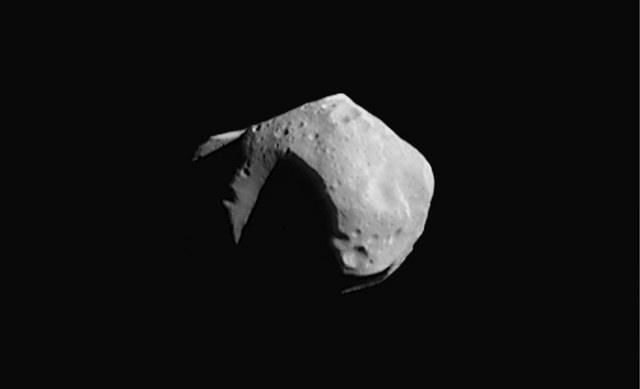NASA is tracking multiple asteroids that will be passing near the Earth in the next couple of weeks, which includes one as big as the tall Empire State Building.

This image mosaic of asteroid 253 Mathilde releaseed by NASA 30 June is constructed from four images acquired by the NEAR spacecraft on 27 June. The images were taken from a distance of 1,500 miles (2,400 kilometers) with sunlight coming from the upper right. The surface exhibits many large craters, including the deeply shadowed one at the center, which is estimated to be more than 6 miles (10 kilometers) deep. The shadowed, wedge-shaped feature at the lower right is another large crater viewed obliquely. Mathilde's angular shape is believed to result from a violent history of impacts.
As per Yahoo, one of the asteroids that NASA or National Aeronautics and Space Administration recently monitored was an asteroid that flew near the Earth. It is nearly the size of the Great Pyramid of Giza in Egypt, sporting a diameter of 525 feet.
The Great Pyramid of Giza-sized asteroid passed by near Earth, or about 3.5 million miles away from it to be exact, last Friday, Oct 15, based on the data of NASA's Center for Near-Earth Object Studies.
NASA Tracks Multiple Asteroids Passing by Earth
NASA classifies these asteroids passing by close to the vicinity of our home planet as Near Earth Objects or NEO.
The US Space Agency further noted that these NEOs are composed of both asteroids and comets that are flying or will be passing near the orbit of the Earth.
Nevertheless, NASA is still tracking these NEOs as part of their space exploration studies. That is even if these near-Earth asteroids are "millions of miles away and can get no closer than millions of miles away, according to the director of the Center for Near Object Studies at NASA's Jet Propulsion Laboratory in Southern California, Paul Chodas.
Aside from the asteroid as big as the Great Pyramid of Giza, which is also known as Asteroid 2021 SM3, another significantly massive Near-Earth Object is passing through in the next few weeks.
According to Unilad's report, the asteroid that is compared to be the size of the iconic Empire State Building is expected to fly past the planet Earth on Nov 13, which is just weeks from now.

A vertical LED illuminated meter located atop the spire of the Empire State Building in New York shows the preliminary results of the midterm US Senate elections on November 04, 2014. As the Senate results are projected and allocated to candidates the LED illuminated meter will ascend in either red or blue reflective of the party.
The said upcoming NEO carries the moniker Asteroid 2004 UE and is said to measure about 1,246 feet in total.
On top of that, another nearby sighting, the Asteroid 1996 VB3, is expected to fly on Earth on Wednesday, Oct. 20. Its size is estimated to be around 690 feet in diameter, which is half the size of the Empire State Building.
What's more, another asteroid called 2017 SJ20 is slated to pass our home planet on Oct. 25, which is 600 feet wide.
Read Also: NASA Simulation Reveals How to Stop Texas-Sized Asteroid-What Protects Earth From Space Collisions?
Asteroids Passing By Earth: Are They Safe?
The NASA center focused on NEOs noted that the multiple massive asteroids that the agency is looking into are something that people should be highly concerned about.
In fact, the agency further added that "the threat to any one person from auto accidents, disease, other natural disasters and a variety of other problems is much higher than the threat from NEOs."
Nonetheless, the space agency added that there is still a slim possibility that these NEOs could hit the surface of the Earth.
Related Article: NASA Plans To Study, NOT MINE, A 'Goldmine' Asteroid Worth QUADRILLIONS By 2026
This article is owned by Tech Times
Written by Teejay Boris









